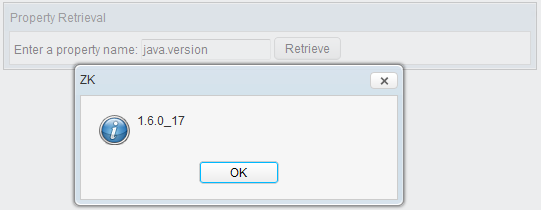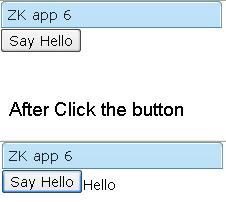Getting Started
![]() This documentation is for an older version of ZK. For the latest one, please click here.
This documentation is for an older version of ZK. For the latest one, please click here.
This chapter describes how to write your first ZUML (ZK User interface Markup Language) page, and demonstrates some ZK's features in really simple examples.
Hello World!
After ZK is installed into your favorite Web server[1], writing applications is straightforward. Just create a ZUML file, say hello.zul[2], as follows under one of the Web application's directories just like as you do for a HTML file.
<window title="My First ZK Application" border="normal">
Hello World!
</window>
Then, browse to the right URL, say http://localhost/myapp/hello.zul, and you got it.
In a ZUML page, a XML element describes what component to create. In this example, it is a window . The XML attributes are used to assign values to properties of the window component. In this example, it sets the window's title to "My First ZK Application" and border to normal.
The text enclosed in the XML elements is also interpreted as a special component called label. Thus, the above example is equivalent to the following.
<window title="My First ZK Application" border="normal">
<label value="Hello World!"/>
</window>
Say Hello in Ajax way
Let us put some interactivity into it.
<button label="Say Hello" onClick='Messagebox.show("Hello World!")'/>
Then, when you click the button, you see as follows.
The onClick attribute is a special attribute used to add an event listener to the component, such that it is invoked when an end user clicks it. The attribute value could be any legal Java code. Notice that it is not JavaScript, and we have to use the double quotes (") to represent a string. Furthermore, to specify a double quote in a XML attribute, we could use single quotes (') to enclose it[3].
Here we invoke Messagebox.show(String) to show a message box as depicted above.
The Java code is interpreted by BeanShell at run time. In additions to event handling, we could embed the code in a ZUML page by specifying it in a special element called zscript. For example, we could define a function to simply the code as follows.
<window title="My First ZK Application" border="normal">
<button label="Say Hello" onClick='alert("Hello World!")'/>
<zscript>
void alert(String message){ //declare a function
Messagebox.show(message);
}
</zscript>
</window>
In fact, alert is a built-in function that you can use it directly in the embedded Java code.
It is Java and runs at the server
The embedded Java code runs at the server so it could access any resource available at the server. For example,
<window title="Property Retrieval" border="normal">
Enter a property name: <textbox/>
<button label="Retrieve" onClick="alert(System.getProperty(self.getPreviousSibling().getValue()))"/>
</window>
where self is a built-in variable that references to the component receiving the event. If we entered java.version and clicks the button, the result is as follows.
Access Component by ID
The access of a component is easier if you assigned an identifier to it. For example, the above code can be simplified if we named the textbox as input as shown below.
<window title="Property Retrieval" border="normal">
Enter a property name: <textbox id="input"/>
<button label="Retrieve" onClick="alert(System.getProperty(input.getValue()))"/>
</window>
Assign component's attribute value without hard coding
Like JSP(JavaServer Pages), you could use EL expressions in ZUML pages. EL expressions use the syntax ${expr}. In the following sample, we set the label value of btn_2 to the label value of btn_1 .
<window title="ZK app 5">
<button id="btn_1" label="Say Hello"/>
<button id="btn_2" label="${btn_1.label}"/>
</window>
Chapter. ZK User interface Markup Language will provide more details on EL expressions. The Developer's Reference and JSP 2.0 tutorials or guides are also good references if you want to know even more.
Design pattern: MVC
If you prefer the MVC(Model-View-Controller) approadch, i.e. you prefer not to embed the handling codes in the window (the view), you can implement a class to handle events. In the example below, onClick event of the button is forwarded to window , and handled by applied class MyComposer .
<window id="win" title="ZK app 6" apply="MyComposer">
<button label="Say Hello" forward="onSayHello" />
</window>
//MyComposer.java
import org.zkoss.zk.ui.event.Event;
import org.zkoss.zk.ui.util.GenericComposer;
import org.zkoss.zul.Label;
public class MyComposer extends GenericComposer {
public void onSayHello(Event evt) {
evt.getTarget().appendChild(new Label("Hello"));
}
}
For more information, please refer to our smalltalk.
Other Feature
ZK has many other features to help you develop your web application easily. Like Data-Binding, Live Data. Please visit our live demo and play around. You'll find the beauty of simple.
Notes
- ↑ Refer to the Quick Start Guide.
- ↑ The other way to try examples is to use ZK Sandbox to run them.
- ↑ If you are not familiar with XML, you might take a look at the XML section.
Quiz
- What event is triggered when a button is clicked? Hint: onXXX?
- What element should be used if you want to write java code in your ZUML?
- What's the benefit to assign id to a component?
- ${expr} is the syntax of?
- What design pattern is mentioned here?




